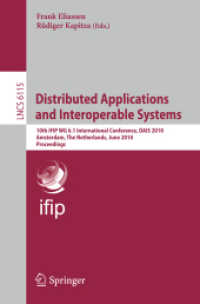- ホーム
- > 洋書
- > ドイツ書
- > Humanities, Arts & Music
- > Linguistics
- > romanic linguistics
Full Description
This book presents a state-of-the-art study of variation that considers meaning—in all its possible facets—as the key to scientific explanation. It brings together a group of international scholars whose work pursues the systematic integration of meaning and function in models of grammatical usage. After a foreword by the world-leading specialist Nikolas Coupland and a theoretical introduction by editors Miguel A. Aijón Oliva and María José Serrano, the seven empirical chapters focus on morphosyntactic phenomena in different varieties of Spanish, analyzing a wide range of discourse types and communicative domains, from sociolinguistic interviews to mass media and social network interactions. These studies offer a basis for the study of variation from similar viewpoints in other languages.
Contents
Nikolas Coupland: Foreword - Miguel A. Aijón Oliva/María José Serrano: Introduction: Variation, choice, and the construction of meaning - Antonio Fábregas: Variation, syntax, and semantics: Person features and the non- specific reading of participants - María José Serrano: Variation of the independent infinitive and the desubjectivizing viewpoint of discourse - Miguel A. Aijón Oliva: Defocusing constructions, viewpoint, and reference: The shaping of public institutions vs. citizens in digital opinion pieces - Benjamin Mielenz: Variation in hypothetical conditional structures in the Spanish of Astorga - Dania Ramos Martín: Subject position in Hispanic yes/ no interrogatives: A description according to utterance pragmatic function and geographical variation in a corpus of written speech - Francisco Javier García Yanes: A semantic approach to mood variation: Habitual and factual clauses introduced by después (de) que - Dunia Catalina Méndez Vallejo: Understanding the Focalizing Ser structure: Going beyond syntax.







